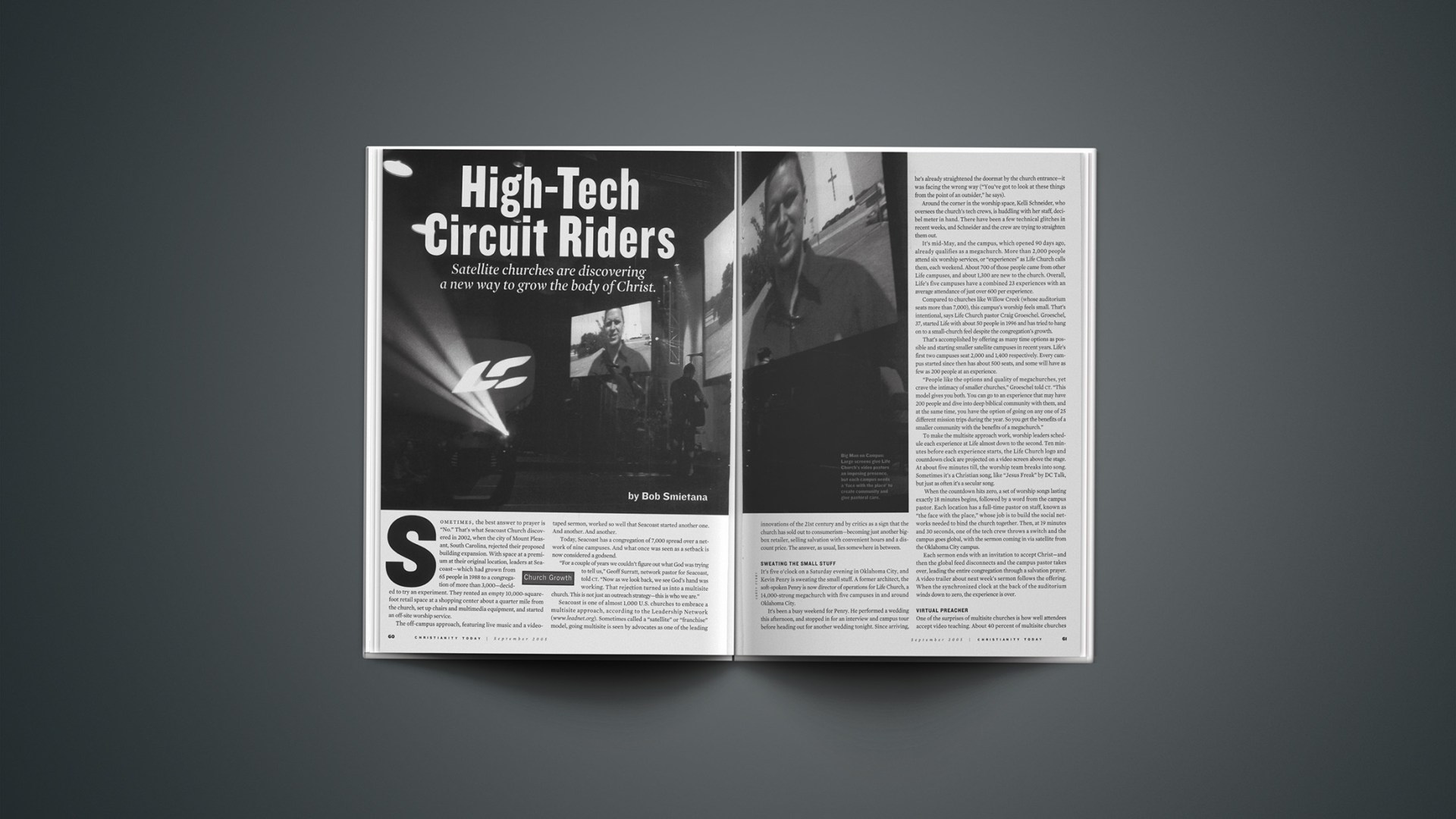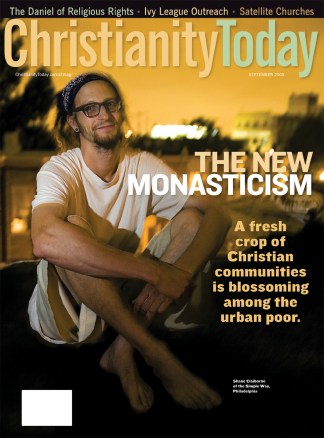Sometimes, the best answer to prayer is “No.” That’s what Seacoast Church discovered in 2002, when the city of Mount Pleasant, South Carolina, rejected their proposed building expansion. With space at a premium at their original location, leaders at Seacoast—which had grown from 65 people in 1988 to a congregation of more than 3,000—decided to try an experiment. They rented an empty 10,000-square-foot retail space at a shopping center about a quarter mile from the church, set up chairs and multimedia equipment, and started an off-site worship service.
The off-campus approach, featuring live music and a videotaped sermon, worked so well that Seacoast started another one. And another. And another.
Today, Seacoast has a congregation of 7,000 spread over a network of nine campuses. And what once was seen as a setback is now considered a godsend.
“For a couple of years we couldn’t figure out what God was trying to tell us,” Geoff Surratt, network pastor for Seacoast, told CT. “Now as we look back, we see God’s hand was working. That rejection turned us into a multisite church. This is not just an outreach strategy—this is who we are.”
Seacoast is one of almost 1,000 U.S. churches to embrace a multisite approach, according to the Leadership Network (www.leadnet.org). Sometimes called a “satellite” or “franchise” model, going multisite is seen by advocates as one of the leading innovations of the 21st century and by critics as a sign that the church has sold out to consumerism—becoming just another big-box retailer, selling salvation with convenient hours and a discount price. The answer, as usual, lies somewhere in between.
Sweating the Small Stuff
It’s five o’clock on a Saturday evening in Oklahoma City, and Kevin Penry is sweating the small stuff. A former architect, the soft-spoken Penry is now director of operations for Life Church, a 14,000-strong megachurch with five campuses in and around Oklahoma City.
It’s been a busy weekend for Penry. He performed a wedding this afternoon, and stopped in for an interview and campus tour before heading out for another wedding tonight. Since arriving, he’s already straightened the doormat by the church entrance—it was facing the wrong way (“You’ve got to look at these things from the point of an outsider,” he says).
Around the corner in the worship space, Kelli Schneider, who oversees the church’s tech crews, is huddling with her staff, decibel meter in hand. There have been a few technical glitches in recent weeks, and Schneider and the crew are trying to straighten them out.
It’s mid-May, and the campus, which opened 90 days ago, already qualifies as a megachurch. More than 2,000 people attend six worship services, or “experiences” as Life Church calls them, each weekend. About 700 of those people came from other Life campuses, and about 1,300 are new to the church. Overall, Life’s five campuses have a combined 23 experiences with an average attendance of just over 600 per experience.
Compared to churches like Willow Creek (whose auditorium seats more than 7,000), this campus’s worship feels small. That’s intentional, says Life Church pastor Craig Groeschel. Groeschel, 37, started Life with about 50 people in 1996 and has tried to hang on to a small-church feel despite the congregation’s growth.
That’s accomplished by offering as many time options as possible and starting smaller satellite campuses in recent years. Life’s first two campuses seat 2,000 and 1,400 respectively. Every campus started since then has about 500 seats, and some will have as few as 200 people at an experience.
“People like the options and quality of megachurches, yet crave the intimacy of smaller churches,” Groeschel told CT. “This model gives you both. You can go to an experience that may have 200 people and dive into deep biblical community with them, and at the same time, you have the option of going on any one of 25 different mission trips during the year. So you get the benefits of a smaller community with the benefits of a megachurch.”
To make the multisite approach work, worship leaders schedule each experience at Life almost down to the second. Ten minutes before each experience starts, the Life Church logo and countdown clock are projected on a video screen above the stage. At about five minutes till, the worship team breaks into song. Sometimes it’s a Christian song, like “Jesus Freak” by DC Talk, but just as often it’s a secular song.
When the countdown hits zero, a set of worship songs lasting exactly 18 minutes begins, followed by a word from the campus pastor. Each location has a full-time pastor on staff, known as “the face with the place,” whose job is to build the social networks needed to bind the church together. Then, at 19 minutes and 30 seconds, one of the tech crew throws a switch and the campus goes global, with the sermon coming in via satellite from the Oklahoma City campus.
Each sermon ends with an invitation to accept Christ—and then the global feed disconnects and the campus pastor takes over, leading the entire congregation through a salvation prayer. A video trailer about next week’s sermon follows the offering. When the synchronized clock at the back of the auditorium winds down to zero, the experience is over.
Virtual Preacher
One of the surprises of multisite churches is how well attendees accept video teaching. About 40 percent of multisite churches use this format, either via satellite or, more commonly, on DVD. The rest use either a campus pastor, rotating team teacher, or a teaching pastor who drives from campus to campus.
Harvest Bible Chapel of Rolling Meadows, Illinois, began using video sermons at two satellite campuses last year. Executive pastor Joe Stowell told CT the church uses DVDs rather than a satellite feed because the format is less expensive and simpler.
The adjustment to video was easy because people were already used to looking at video screens at Harvest. The main campus, a converted warehouse that seats 2,000, has video screens that compensate for poor sightlines. “It’s a flat environment—there’s no balcony, no slant or slope to the seating—and there are big screens up front,” Stowell says.
What surprised Stowell (whose father, former Moody president Joe Stowell, joined Harvest as teaching pastor earlier this year) is how interactive video sermons can be. When pastor James MacDonald tells a joke, people laugh. When he asks them to raise their hands, they do.
“And when he is telling a serious story, you can hear a pin drop,” Stowell says. “It’s is the same thing as going to a movie theater. You go to a movie theater and everyone laughs at the jokes and people cry at the right time.”
As it turns out, having a live pastor on campus is more important than having a live preacher. At first, Harvest leaders thought all they needed was a live worship band, an emcee, and someone to push play for the DVD. But that left the congregation feeling disconnected.
“We had to change our minds within three or four weeks,” Stowell says. “Without the staff pastor assigned here, leading small groups and praying with people, it got a little thin.”
Harvest, like Willow Creek and other multisite churches, got around that sense of disconnection by adding a staff pastor for the campus. Still, the disconnect between the “virtual preacher” and the congregation concerns Eddie Gibbs, professor of church growth at Fuller Theological Seminary.
“It removes the preacher from the community,” Gibbs told CT, “and I’ve got some problem with that. Ministry requires an ongoing dialogue with the community.”
Gibbs is quick to point out that many of the leaders in the multisite movement are “people of great integrity.” Still, by using a video sermon, churches risk turning their teaching pastor into a celebrity. And that, he says, can be a form of idolatry.
A regular diet of video teaching also turns a sermon—a word aimed at a specific audience—into generic spiritual information, Gibbs says.
“That perpetuates the chronic problem that we have of undiscipled church members,” he says. “We grow in Christ not just by hearing good stuff but through relationships. The ministry of the teaching pastor flows out of those relationships. That’s how preachers know what to preach about, not just sitting alone in their study getting private revelation from the Lord.”
That issue can be overcome, Gibbs says, by relying more heavily on the campus pastor to provide context for the message. That could be as simple as the campus pastor saying, “Okay, we’ve heard from Bill Hybels, now let’s talk about what it means here in our community.”
The 30-Minute Problem
Willow Creek started its Wheaton satellite campus in 2001 as a response to “the 30-minute problem.” Jim Tomberlin, who oversees Willow’s three satellite campuses, says that once people drive more than 30 minutes one way to church, their involvement drops off dramatically. More than one-third of Willow attendees were driving that far—and as a result, were not joining small groups or inviting their friends to church. That was undermining Willow’s whole model, Tomberlin told CT.
“So we decided,” he says, “if you can’t get the people to the mountain, bring the mountain to the people.”
Each of Willow Creek’s satellites is located near a cluster of people who used to drive to the South Barrington, Illinois, campus. Each site has a small Seeds bookstore and Harvest eating area, modeled after the main campus, and averages about 1,000 in attendance. Similarly, each uses the same bulletins and has the same Willow logo. Even the parking lot directors wear the same orange jackets—so that when people drive up, they immediately feel like they are at Willow. Tomberlin says, “We do the same things same way you would do at Starbucks or a McDonald’s or a brand name that works.”
Willow Creek’s goal is to have 10 campuses started in the Chicago area by 2010, so that no one will have to drive more than 30 minutes to get to one of their sites. Each site takes at least a year to develop, with most of that time spent finding the right facility to lease. Startup costs include between $300,000 and $500,000 for equipment. So far each campus has become immediately self-sufficient.
“It’s a lot cheaper than buying and putting up a building, and you’ve got an instant congregation,” he says. “Because you are not consumed with huge amounts of debt or trying to buy land, you can be focused on ministry.”
Then there are the zoning battles when it comes to building a megachurch. Fuller’s Gibbs says there are few places left, especially in newer suburbs, where it’s feasible to build a megachurch. “We may be saturated in terms of megachurch construction,” he says.
Bayside Church, in Granite Bay, California, decided to try the multisite approach after a seven-year zoning battle over its first permanent building. The church’s attendance has grown from 4,000 when the building opened two years ago to more than 7,000 today. But senior pastor Ray Johnston and other leaders had no interest in starting another battle over a building expansion.
Instead Bayside, which like Life Church is part of the Evangelical Covenant Church, launched a program to start 20 new campuses in the next five years. Their approach is a combination of multisite and church plant. Each Bayside location will share a common name and core values. But rather than each site having the same sermon, the preaching will be tailored to each location.
That’s essential, Johnston says, because the campuses will be in distinctive demographic areas. The main campus in Granite Bay serves a community that is predominantly white, with a median household income of a little more than $100,000. Bayside of South Sacramento or “boss,” on the other hand, serves a multiracial community where the median household income is $35,000. So Johnston partnered with his friend, Sherwood Carthen, an African American pastor and chaplain of the Sacramento Kings, to open the new campus. Launched last year, boss already has an average attendance of 500. A third campus averages close to 300 people.
The Franchise Effect
Johnston sees the multisite approach as vastly superior to a stadium-sized megachurch. He draws a comparison to the franchise movement in business to make his point. “You can either build a mega-McDonald’s or a bunch of small ones,” he says. “The question is which will feed more people?”
The idea behind multisite or franchise churches is the same one that’s made chain stores successful—take a system that works, and duplicate it over and over. When a new location starts up, leaders don’t have to reinvent children’s ministries or small-group programs.
The new location also opens up opportunities for church members to get involved in the ministry. When Harvest Bible Chapel opened their Elgin campus last year, they needed 100 volunteers “right away” Stowell says, to welcome visitors, teach children’s ministries, lead small groups—turning people who once might have sat on the sidelines into contributing members. “We find ourselves having to rely on the people in the church, more than we ever have before, which I think is a good thing.”
Building a multisite network also means those locations can share resources and create economies of scale. That makes building multisites different from church planting.
Greg Ligon of the Leadership Network says that in most cases, “Church planting means, ‘Here’s some money, good luck.'” In a multisite, congregations build close relationships and each campus has a stake in making sure they all thrive.
Roger Finke, a Penn State sociologist and coauthor of The Churching of America, 1776-1990: Winners and Losers in Our Religious Economy, sees a parallel between the multisite or franchise approach and the Methodist circuit riders of the 19th century.
“The Methodist circuit rider was basically the pastor for multiple satellite churches,” Finke told CT. “They tried to start up satellite congregations as quickly and as cheaply as possible. When the circuit rider was not there during the week, the satellite had a class leader or layperson who kept things going. Then the circuit rider would come in every once in a while and fire people up.”
Methodists used that approach to become one of the largest religious groups in the United States, moving from “less than 2.5 percent of church adherents in 1776 to more than 34.2 percent in 1850,” Finke wrote in a 2004 article for the Journal for the Scientific Study of Religion.
Finke says multisite churches can draw on the methods used by Wesleyans and other denominations—a core set of teachings and a standard model of doing church—and still claim to be doing something new because of their innovative practices. “One of the problems with mainline churches now is that the brand or core teaching has changed, while at the same time church bureaucracy has strangled innovation,” he says.
So, are multisite churches creating new denominations?
Tomberlin says this issue is something Willow Creek and others with satellite churches have to grapple with. “It has the potential of all the good things of a denomination, where you’ve got some centralized resources, some centralized beliefs, and core practices that you can leverage and maximize,” he says. “Sometimes in our circle of churches, we are anti-denomination. But I am starting to think that becoming a denomination is not all bad.”
Bob Smietana is features editor of The Covenant Companion.
Copyright © 2005 Christianity Today. Click for reprint information.
Related Elsewhere:
Recent news stories on satellite churches include:
Multisite churches take center stage | In recent years, a new strategy has emerged that is focused on one church that meets at multiple locations. These multisite churches have discovered a new way to expand demographically and geographically beyond traditional boundaries. (Church Executive, August 24, 2005)
Satellite link between churches could spread Gospel faster | A trend more common in urban megachurches could be the salvation of a tiny country church. (Shreveport Times, La., August 9, 2005)
Big Churches Use Technology to Branch Out | Now some mega-churches are trying to reverse the trend by creating smaller satellite “campuses.” Among them is Willow Creek Community Church, outside Chicago, where Rev. Jim Tomberlin serves as regional pastor. (All Things Considered, August 7, 2005, NPR)
Earlier Christianity Today articles on Willow Creek’s attempt at establishing satellite churches include:
Mega-Ministers | Bill Hybels and fourth-century preaching star John Chrysostom would have a lot to talk about. (June 15, 2001)
Forget Televangelists; How About Going to Church to Watch TV? | Megachurches getting so mega they’re building moons (June 13, 2001)
Willow Creek Fishes In a Crowded Stream | Willow Creek aims for the unchurched … in Wheaton (July 24, 2001)
CT reported that Max Lucado is attempting to add satellite campuses to his church.
Our sister publication, Leadership Journal featured an article by a multi-site church pastor.










